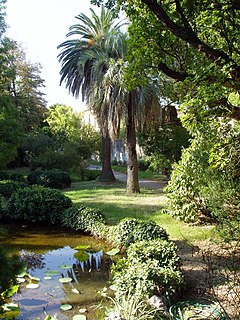
A botanical garden or botanic garden is a garden dedicated to the collection, cultivation, preservation and display of a wide range of plants labelled with their botanical names. It may contain specialist plant collections such as cacti and other succulent plants, herb gardens, plants from particular parts of the world, and so on; there may be greenhouses, shadehouses, again with special collections such as tropical plants, alpine plants, or other exotic plants. Visitor services at a botanical garden might include tours, educational displays, art exhibitions, book rooms, open-air theatrical and musical performances, and other entertainment.

The Montreal Botanical Garden is a large botanical garden in Montreal, Quebec, Canada comprising 75 hectares of thematic gardens and greenhouses. It was designated a National Historic Site of Canada in 2008 as it is considered to be one of the most important botanical gardens in the world due to the extent of its collections and facilities.
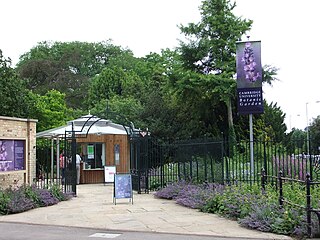
The Cambridge University Botanic Garden is a botanical garden located in Cambridge, England associated with the university Department of Plant Sciences. It lies between Trumpington Road to the west, Bateman Street to the north and Hills Road to the east.

The Royal Botanic Garden Edinburgh (RBGE) is a scientific centre for the study of plants, their diversity and conservation, as well as a popular tourist attraction. Founded in 1670 as a physic garden to grow medicinal plants, today it occupies four sites across Scotland—Edinburgh, Dawyck, Logan and Benmore—each with its own specialist collection. The RBGE's living collection consists of more than 13,302 plant species, whilst the herbarium contains in excess of 3 million preserved specimens.

The University of California Botanical Garden is a 34-acre botanical garden located on the University of California, Berkeley campus, in Strawberry Canyon. The Garden is in the Berkeley Hills, inside the city boundary of Oakland, with views overlooking the San Francisco Bay. It is one of the most diverse plant collections in the United States, and famous for its large number of rare and endangered species.

Drosera adelae, commonly known as the lance-leaved sundew, is a carnivorous plant in the genus Drosera that is endemic to Queensland, Australia.
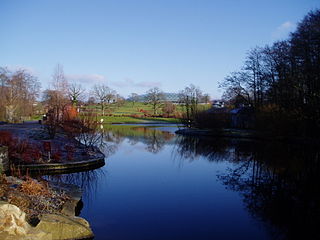
The National Botanic Garden of Wales is a Botanical Garden located in Llanarthney in the River Tywi valley, Carmarthenshire, Wales. The garden is both a visitor attraction and a centre for botanical research and conservation, and features the world's largest single-span glasshouse measuring 110 m (360 ft) long by 60 m (200 ft) wide.

Katherine Olivia "Kate" Sessions was an American botanist, horticulturalist, and landscape architect closely associated with San Diego, California, and known as the "Mother of Balboa Park."

Ulmus 'Homestead' is an American hybrid elm cultivar raised by Alden Townsend of the United States National Arboretum at the Nursery Crops Laboratory in Delaware, Ohio. The cultivar arose from a 1970 crossing of the Siberian Elm Ulmus pumila with the hybrid N 215, the latter grown from seed sent in 1960 to the University of Wisconsin-Madison elm breeding team by Hans Heybroek of the De Dorschkamp Research Institute in the Netherlands. 'Homestead' was released to commerce without patent restrictions in 1984.
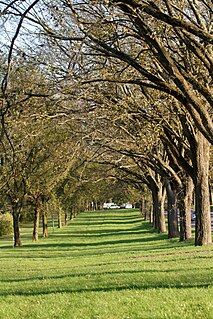
The American Elm cultivar Ulmus americana 'Princeton' was originally selected in 1922 by New Jersey nurseryman William Flemer of Princeton Nurseries for its aesthetic merit. 'Princeton' was later found to have a moderate resistance to Dutch elm disease (DED).
The Chinese Elm cultivar Ulmus parvifolia 'Dynasty' is a United States National Arboretum introduction reputed to be very fast-growing.
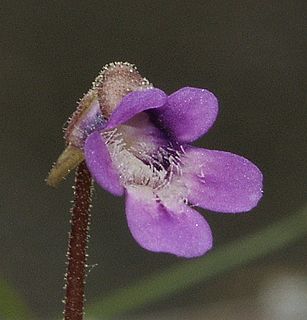
Pinguicula vulgaris, the common butterwort, is a perennial carnivorous plant in the bladderwort family, Lentibulariaceae. It grows to a height of 3–16 cm, and is topped with a purple, and occasionally white, flower that is 15 mm or longer, and shaped like a funnel. This butterwort grows in damp environments such as bogs and swamps, in low or subalpine elevations. It has a generally circumboreal distribution, being native to almost every country in Europe as well as Russia, Canada, and the United States. Being native to environments with cold winters, they produce a winter-resting bud (hibernaculum). There are three forms originating from Europe: P. vulgaris f. bicolor which has petals that are white and purple; P. vulgaris f. albida which has all white petals; and P. vulgaris f. alpicola which has larger flowers. The taxonomic status of these forms is not universally recognised - see e.g. The Plant List.

Carnivorous plants are plants that derive some or most of their nutrients from trapping and consuming animals or protozoans, typically insects and other arthropods. Carnivorous plants have adapted to grow in places where the soil is thin or poor in nutrients, especially nitrogen, such as acidic bogs. Charles Darwin wrote Insectivorous Plants, the first well-known treatise on carnivorous plants, in 1875. Carnivorous plants can be found on all continents except Antarctica, as well as many Pacific islands.

Ulmus parvifolia, commonly known as the Chinese elm or lacebark elm, is a species native to eastern Asia, including China, Taiwan, Japan, North Korea,south Korea and Vietnam. It has been described as "one of the most splendid elms, having the poise of a graceful Nothofagus".

Peter D'Amato is an American author, businessman, and carnivorous plant authority. He is the owner of California Carnivores, located in Sebastopol, possibly the largest nursery of carnivorous plants in the world, and the author of The Savage Garden, a book on the cultivation of insectivorous plants. His book won the American Horticultural Society Book Award and the Quill & Trowel Award from the Garden Writers Association of America, both in 1999.

Kew Gardens is a botanic garden in southwest London that houses the "largest and most diverse botanical and mycological collections in the world". Founded in 1840, from the exotic garden at Kew Park in Middlesex, England, its living collections includes some of the 27,000 taxa curated by Royal Botanic Gardens, Kew, while the herbarium, which is one of the largest in the world, has over 8.5 million preserved plant and fungal specimens. The library contains more than 750,000 volumes, and the illustrations collection contains more than 175,000 prints and drawings of plants. It is one of London's top tourist attractions and is a World Heritage Site.

Lee and Kennedy were two families of prominent Scottish nurserymen in partnership for three generations at the Vineyard Nursery in Hammersmith, west of London. "For many years," wrote John Claudius Loudon in 1854, "this nursery was deservedly considered the first in the world."
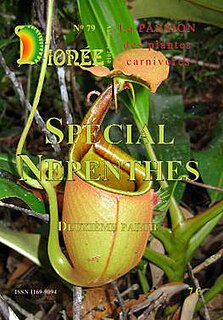
Dionée is a quarterly French-language periodical and the official publication of Association Francophone des Amateurs de Plantes Carnivores, a carnivorous plant society based in France. Typical articles include matters of horticultural interest, field reports, and scientific studies. The journal was established in 1983 and has been published in full colour from issue 68 onwards. It is printed in A5 format and totals around 160 pages annually. New issues are usually released in the months of March, June, September, and December.

The Savage Garden: Cultivating Carnivorous Plants is a carnivorous plant cultivation guide by Peter D'Amato, horticulturist and owner of California Carnivores nursery. It was originally published in 1998 by Ten Speed Press, and reprinted in 2004. A revised edition was released in July 2013.



















